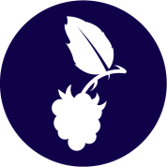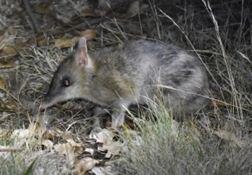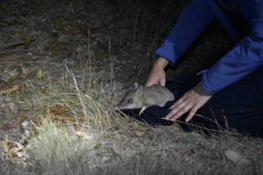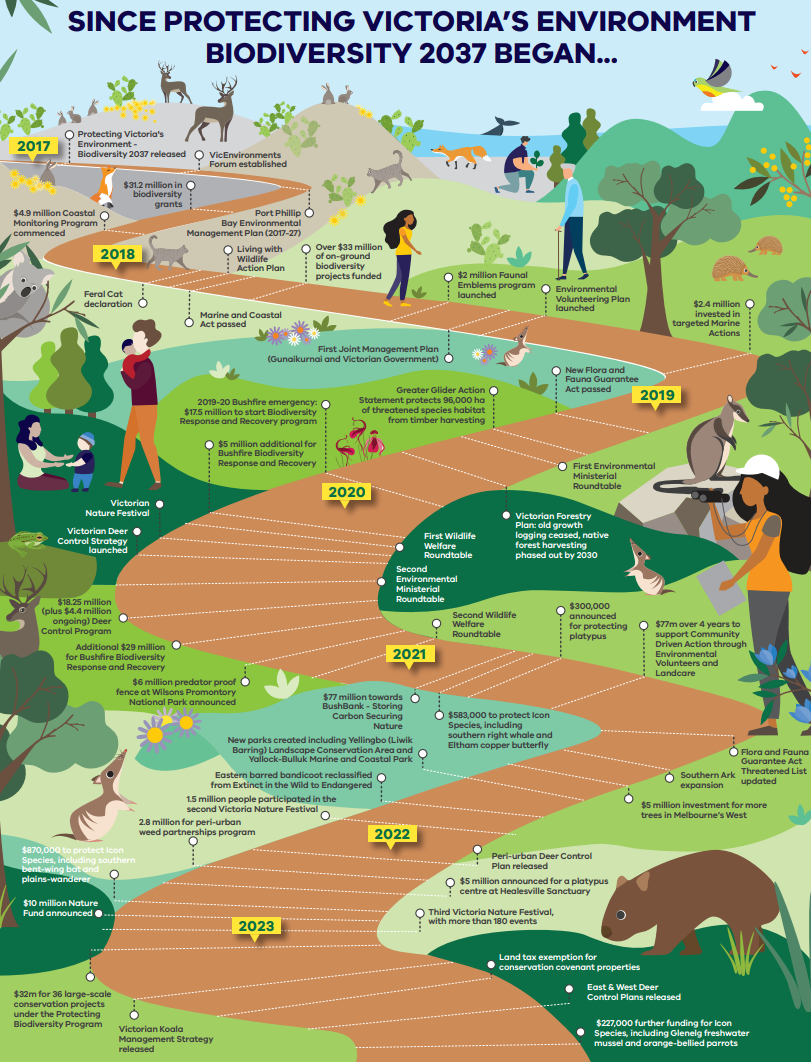Keeping the natural environment healthy
Protecting Victoria’s Environment – Biodiversity 2037, launched in 2017, is Victoria’s plan to stop the decline of our native plants and animals and improve our natural environment.
The plan is underpinned by 2 goals – Victoria’s natural environment is healthy and Victorians value nature.
The plan set out ambitious statewide targets and contributing targets for both goals.
Annual Protecting Victoria’s Environment – Biodiversity 2037 progress reports provide a snapshot of how Victoria is performing against the targets. These reports include contributions made by all the government and non-government organisations that are working to improve the natural environment.
Significant progress has been made in the past 5 years towards these targets, despite the challenges of climate change, the 2019–20 bushfires and COVID-19. The action being undertaken is delivering tangible outcomes for the environment and improving the outlook for our native plants, wildlife and landscapes.
We are working towards achieving our Biodiversity 2037 targets, but we still have a long way to go to stop biodiversity decline in Victoria.
We all need to continue working together – across government, business, the community and Traditional Owners – to ensure that we have a healthy environment to support a healthy society.
Explore examples of Victorian Government initiatives supporting biodiversity and threatened species.
Goal – Victoria's natural environment is healthy
Protecting Victoria’s Environment – Biodiversity 2037 has 5 targets for on-ground management to protect biodiversity.
These landscape-scale activities benefit multiple species, including some that are threatened, and aims to prevent other species from becoming threatened.
The targets focus on hectares of action in priority locations.
Our Strategic Management Prospects tool is used to identify priority locations and actions that provide the highest potential return on investment for biodiversity.
Biodiversity 2037 targets for on-ground action
 | 4 million hectares of pest herbivore control per year |
| 1.5 million hectares of pest predator control per year |
| 1.5 million hectares of weed control per year |
| 200,000 hectares of revegetation |
| 200,000 hectares of new permanently protected areas |
Protecting our threatened species
Biodiversity 2037 partners go to great lengths to look after our threatened species – from rafting down rivers to collect seed, to captive breeding and release programs.
Some threatened species need targeted assistance, as they don’t receive enough benefit from landscape-scale actions like pest animal or weed control.
Here are some examples of work happening across the state to make sure our threatened species have a positive future.
Orange-bellied Parrot
Neophema chrysogaster
Flora and Fauna Guarantee Act (FFG) listing: Critically Endangered
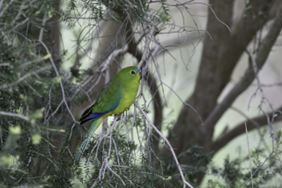
The Orange-bellied Parrot is one of only three migratory parrots in the world. Not much larger than a budgerigar, the parrots spend winter feeding along the coasts of Victoria and South Australia, before flying to Melaleuca in south-west Tasmania every summer to breed.
What’s being done?
In 2016, fewer than 50 Orange-bellied Parrots existed in the wild. The National Recovery Team urgently needed to determine the best way to release captive-bred Orange-bellied Parrots to bolster the wild population.
The team began trialling four different release methods simultaneously, and in 2019 partnered with DEECA to conduct a Specific Needs Assessment.
This process helped the team have more confidence that the best course of action was to release a higher number of young captive-bred birds to help the population grow.
The changed strategy has already helped the wild population grow. For the past four years, over 100 Orange-bellied Parrots have made the northern migration.
A population that had been declining for 40 years is now growing, and in autumn 2023, 139 parrots were estimated to be leaving Melaleuca to begin their annual migration to the mainland.
How can you help?
- Join a volunteer bird count survey through Birdlife Australia
- If you manage coastal property with Orange-bellied Parrot habitat, contact your local Catchment Management Authority, council or DEECA regional office to learn what support and funding may be available
Plains-wanderer
Pedionomus torquatus
FFG listing: Critically Endangered
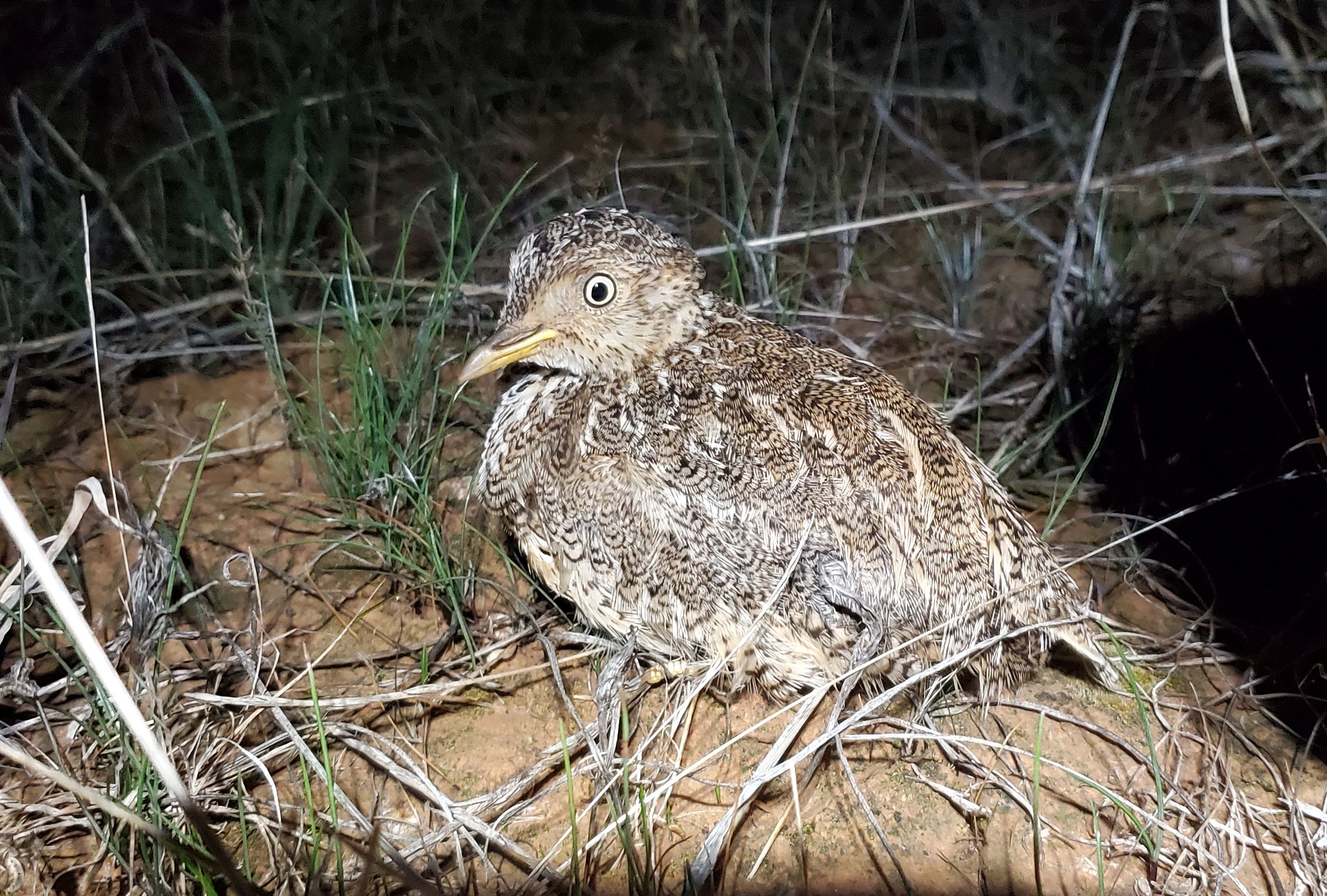
Plains-wanderers are elusive birds found primarily in Victoria’s Northern Plains Grasslands in north-central Victoria.
As the only surviving member in their branch of the evolutionary tree, there is nothing quite like them anywhere else on earth.
Much of the Plains-wanderer's range overlaps with land used for agricultural practices. As such, most of their habitat has been removed or is now less suitable. Looking after the places they call home today is a critical part of their recovery.
What’s being done?
Government agencies, Traditional Owners, non-government organisations and private landholders are working together across public and private land to help the species recover. They are creating suitable habitat and managing agriculture to retain suitable habitat for plains wanderers.
As a result, Plains-wanderer numbers have increased and there are now two stable breeding populations in northern Victoria, the best result for more than fifteen years.
A captive breeding program involving the Werribee Open Range Zoo is also being trialled. Numerous birds have been brought into captivity and bred since 2018.
Adult birds that have been bred at the Zoo are being experimentally released and monitored to determine a strategy where captive-bred birds could help to further boost numbers in the wild. Birds are being monitored using audio and thermal imaging, and capture-recapture methods.
A genetic analysis will provide further information about the population.
How can you help?
- Sign up to the Plains-wanderer Song Meter citizen science program and help identify calls
- Attend a Friends of Terrick Terrick National Park planting day
- Volunteer to help Parks Victoria conduct nocturnal surveys of Northern Plains Grasslands
- If you live near a native grassland or reserve, keep your cat indoors
Spotted Tree Frog
Litoria spenceri
FFG listing: Critically Endangered
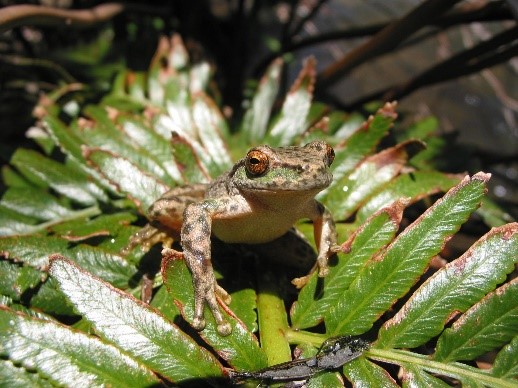
Photo credit: Glen Johnson
In Victoria, Spotted Tree Frogs are restricted to remote mountainous river systems in the state’s north-east.
Threats to the species include disease caused by chytrid fungus, and more frequent and severe fires associated with climate change. Predation by trout, a non-native fish, is a further challenge.
The 2019–20 bushfires impacted much of the Spotted Tree Frog’s range. Bushfires can result in direct death of frogs, but the challenges for the frogs continue after the fires are out. The spread of disease is enhanced, and rain clogs waterways with ash and sediment, making it difficult for the frogs to breed.
What’s being done?
Victoria’s Bushfire Biodiversity Response and Recovery program has helped protect the frog’s future. Populations were monitored to understand the direct and indirect impacts of the fire and clarify disease status in the frogs. Remote populations were accessed by helicopter. The monitoring has informed the way we manage threats.
Control of deer in the area following the fires helped native plants recover. This in turn is supporting healthy waterways and frog populations.
At one important site, anglers have been helping by removing trout to reduce the threat to the frogs.
A new captive breeding program led by Zoos Victoria has been established to look after small numbers of individuals from at-risk populations. It has produced more frogs to increase numbers back in the wild. The program is helping restore and re-establish this species as its habitat recovers.
How can you help?
- Record frog calls with the FrogID or Frog Census apps – scientists listen to the calls and the data informs the protection and conservation of frogs.
Eastern Barred Bandicoot
Perameles gunnii
FFG listing: Endangered
|
|
Photo credits: Ryan Davis
A small endangered nocturnal marsupial, the Eastern Barred Bandicoot was once widespread across the grasslands and grassy woodlands of western Victoria.
In the 1980s, the last remaining Eastern Barred Bandicoots were found in a rubbish tip near Hamilton.
Thanks to the incredible efforts of the recovery team, volunteers, government agencies and other partners, this species is now making a comeback.
What’s being done?
A captive breeding program over many years helped return these wonderful marsupials to the wild. Bandicoots were released into fenced fox-free reserves within their original range in south west Victoria.
More recently, they have been released onto the fox-free Phillip, Churchill and French Islands, while others were released into farmland protected by Maremma dogs and into a fox and cat-free area on private land near Skipton. The captive breeding program was so successful in restoring bandicoot numbers, it is no longer needed.
In 2021, the species had their conservation status changed from extinct in the wild to endangered. This was the first time in Australia a species has had its conservation status improved from ‘extinct in the wild’. The reclassification is a step in the right direction.
Yet, there is more work ahead to secure the species’ future. The current focus is on increasing the genetic diversity of Eastern Barred Bandicoots by introducing new genetics from a close relative, the Tasmanian Eastern Barred Bandicoot. This will make Victoria’s bandicoots more resilient to a rapidly changing environment due to climate change.
How can you help?
- Join Conservation Volunteers Australia as they monitor bandicoots and protect their habitat.
Snowy River Westringia
Westringia cremnophila
FFG listing: Endangered
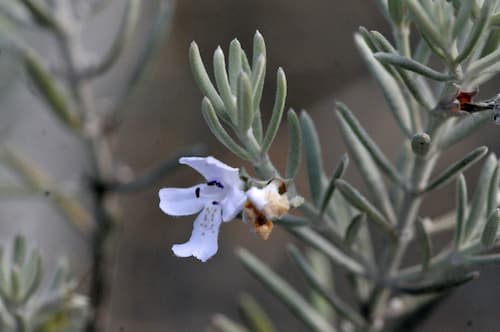
Snowy River Westringia is a silver-grey shrub that occurs only on steep cliffs in the Snowy River Gorge in north-eastern Victoria. It is threatened by droughts and fires.
What’s being done?
The species faced extinction when its entire range was burned in the 2019-20 bushfires. Experts from Royal Botanic Gardens Victoria (RBGV) went to extraordinary lengths, rafting 100 km along the Snowy River to search for remaining plants. Of the estimated 500 plants before the fire, only 60 survived.
Cuttings from five plants are being grown in RBGV’s living collection. These flowered for the first time in January 2023, but as yet no seed has set on plants in cultivation. More seed and propagation material will be collected on a future trip.
Seeds from other fire affected species are stored in the Victorian Conservation Seed Bank. The seed bank is providing insurance in the event of future environmental disasters.
How can you help?
- Learn more about the work of the Royal Botanic Gardens Victoria to save threatened plant species.
Goal – Victorians value nature
All Victorians play an important role in protecting our native species and natural environment. Connecting with nature is also good for our health and wellbeing.
Encouraging more Victorians to connect with and act for nature are key goals of Protecting Victoria’s Environment – Biodiversity 2037.
Evidence shows that people who have a greater connection with nature are more likely to value nature and take action to protect the natural environment.
Regular online surveys collect information about how Victorians are connecting with and acting for nature.
Partnerships and learning together are key
DEECA is working together with many organisations to understand how to foster more connection to nature and encourage people to do more actions more often. Partners include:
- BehaviourWorks Australia at Monash University
- BirdLife Victoria
- Coastcare Victoria
- Commissioner for Environmental Sustainability
- Environmental Protection Authority
- Federation of Victorian Traditional Owners Corporation
- ICON Science at RMIT University
- Landcare Victoria
- Parks Victoria
- Phillip Island Nature Parks
- Royal Botanic Gardens
- Remember the Wild
- RSPCA Victoria
- Sustainability Victoria
- Traditional Owners and Aboriginal communities
- Trust for Nature
- Vic Catchments
- Victorian Landcare Program
- Zoos Victoria
| All Victorians connecting with nature |
| 5 million Victorians acting to protect the natural environment |
All Victorian Government organisations that manage environmental assets contribute to environmental-economic accounting |
Since the plan began
Our shared journey since the launch of the Biodiversity 2037 plan in 2017 has included many significant initiatives, investments and milestones.
Recent program announcements will continue to drive progress toward the targets by controlling threats and improving and protecting habitat for biodiversity.
These include the:
- Peri-urban Deer Control Plan, West Deer Control Plan, East Deer Control Plan
- $77 million BushBank program
- $10 million Nature Fund
- more than $1 million further funding to Icon species
- continued support for community-driven action, including Landcare
- Protecting Biodiversity program that has allocated $32 million for 36 large-scale conservation projects across Victoria in 2022 and 2023.
Previous progress reports
The 2022 Progress report outlines the achievements of government environmental agencies and partners in delivering on the priorities and themes of Biodiversity 2037 over the 2021 and 2022 reporting period. This report includes a summary and overview of each target and a selection of case studies highlighting what is being done to help protect native plants and animals.
This Progress report shows that meaningful progress has been made towards the Biodiversity 2037 targets since reporting began in 2018-19, despite the challenges of the Black Summer bushfires, climate change, and the COVID-19 pandemic. However, there is still a significant amount of work to do to reverse the decline in Victoria’s biodiversity.
How we are tracking against our targets in the Biodiversity 2037 Plan
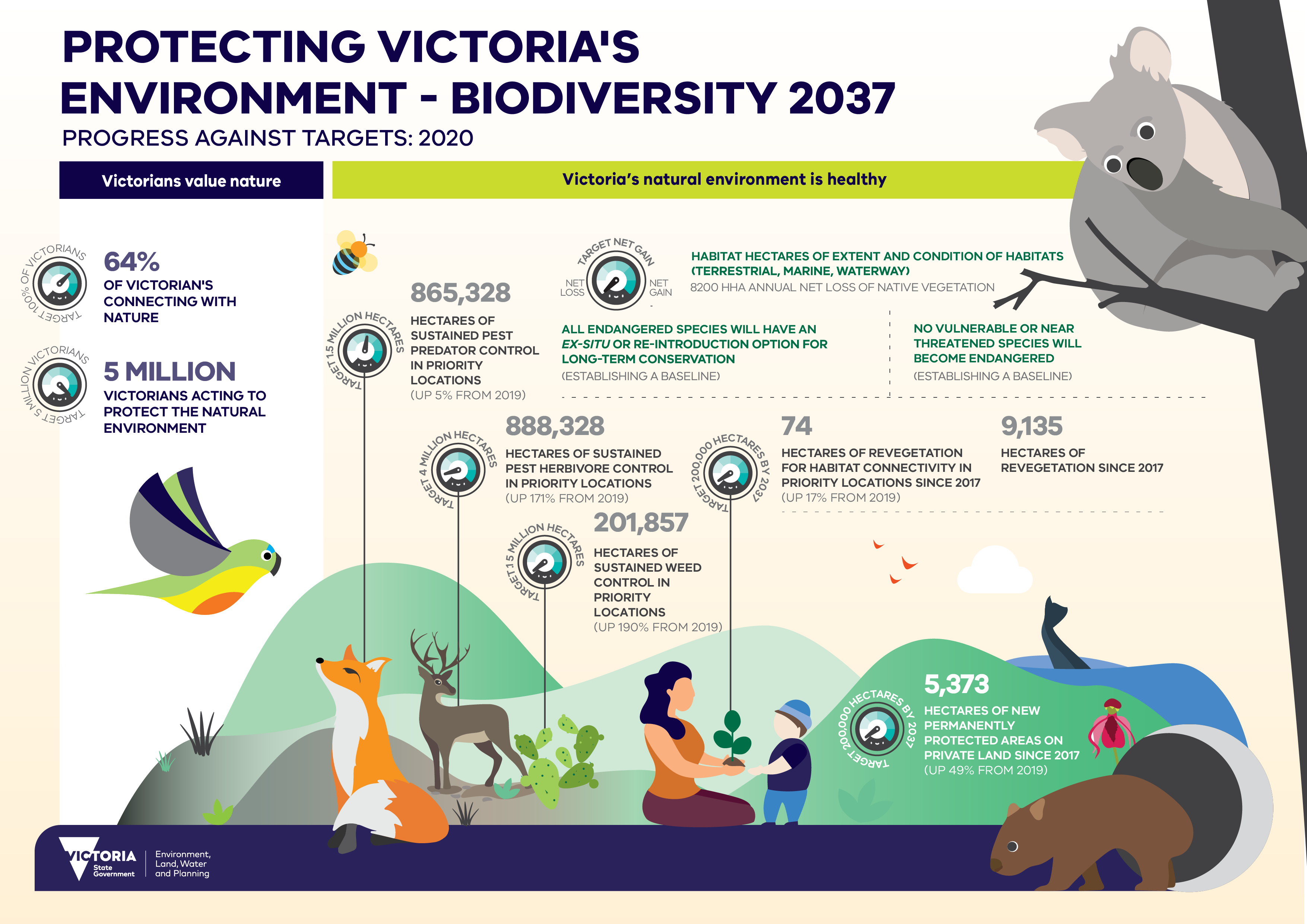
Priority locations are generally the top 10% of locations across Victoria where management actions maximise benefits to threatened (and other) species. The hectares of activity in priority locations that contribute to the Biodiversity 2037 Plan targets are therefore only a part of the total effort across Victoria, and some of this activity is driven by outcomes other than biodiversity. For example, revegetation is undertaken for purposes including erosion control and improvement of water quality, as well as enhancing biodiversity.
Delivering on our targets
The 2020-21 and 2021-22 Victorian Budgets invested over $286 million towards protecting Victoria’s biodiversity. This builds on the 2017-18 Budget, which committed $86.3 million over 4 years plus $20 million per year ongoing to deliver on the 20-year Biodiversity Plan.
The following recent initiatives will increase our delivery against the targets:
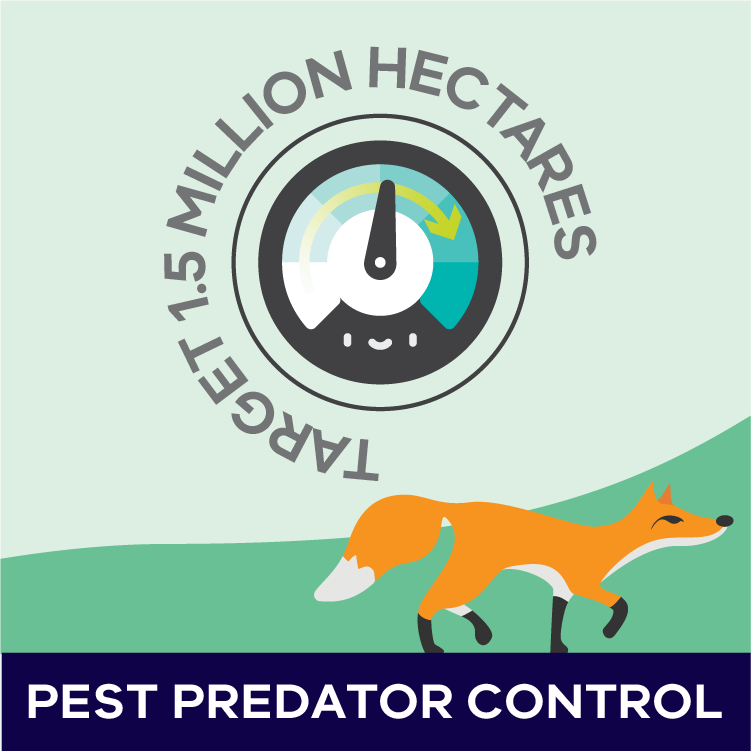 | $6 million to fund a predator-proof fence at Wilsons Promontory National Park to protect the unique plants and animals (announced November 2020). |
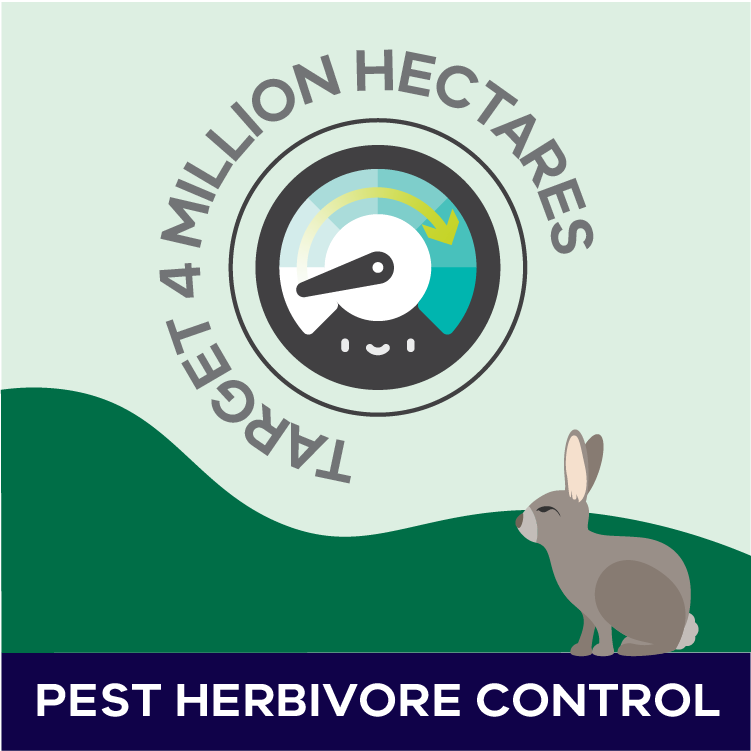 | $18.25 million Deer Control Program (2021-24) plus $4.4 million ongoing from 2024-25 (announced November 2020). $29 million for Biodiversity Bushfire Response and Recovery (BBRR) announced November 2020 adding to the $22.5 million for immediate response in early 2020. The BBRR program has a major focus on pest herbivore control. |
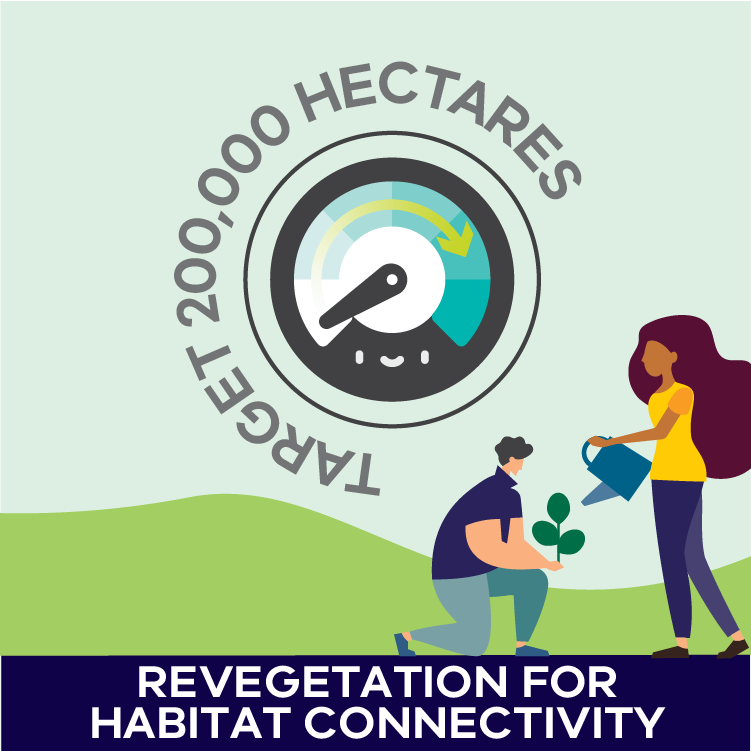 | $77 million BushBank - Nature restoration for carbon storage program, including revegetation for habitat connectivity. |
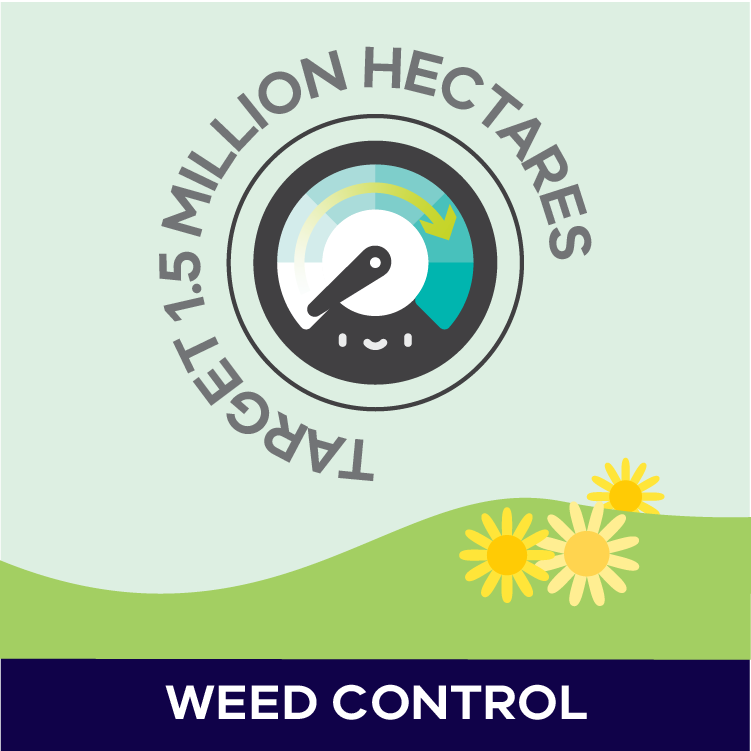 | Increased targeting of effort of community programs to contribute to Biodiversity 2037 targets through new grants programs, for example, Community volunteer action grants biodiversity stream). |
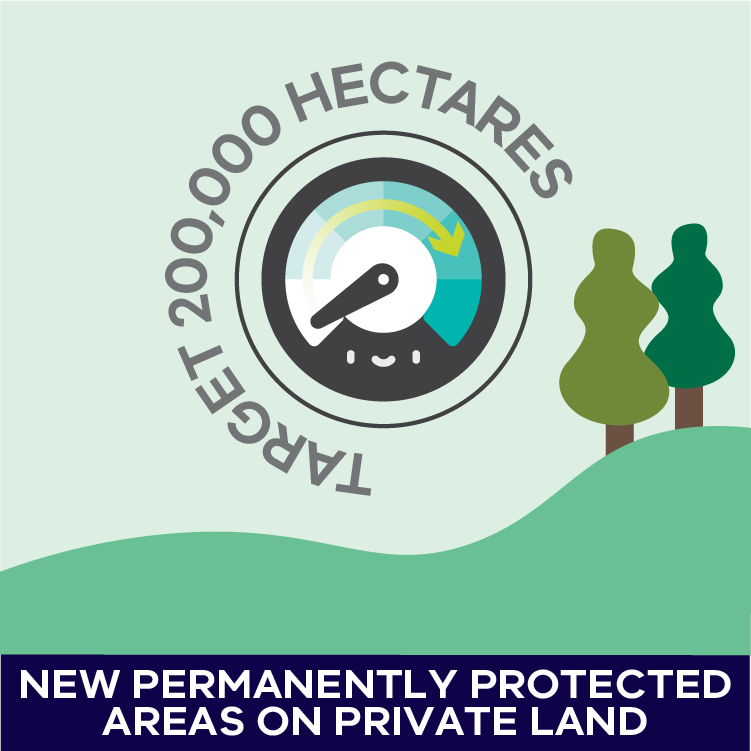 | $4 million over 4 years and $1 million ongoing to support Trust for Nature contribute to the permanent protection of biodiversity on private land (announced May 2021). |
2020 Case Studies
Bushfire Biodiversity Response and Recovery 2020
Learn more about the response and recovery actions that took place in response to the devastating 2019–2020 bushfires.
This work largely contributes to the targets under the goal 'Victoria's natural environment is healthy' in the Biodiversity 2037 Plan.
Victorian Nature Festival 2020
The Victorian Nature Festival was a nature celebration event that took place online in 2020. Through online presentations, videos, podcasts, virtual tours, and art and craft activities, Victorians were able to enjoy, learn about and connect to Victoria’s incredible biodiversity.
This work contributes to the targets under the goal 'Victorians Value Nature' in the Biodiversity 2037 Plan.
See the video below for an overview of the event:
See the infographic and case studies below for progress on the biodiversity targets in 2019.
The analysis against targets in the 2019 report utilised full threat management data only, consistent with improved standards for data capture and reporting since the 2018 report.
This provides a more conservative estimate of the progress made towards achieving the Biodiversity 2037 Plan targets.
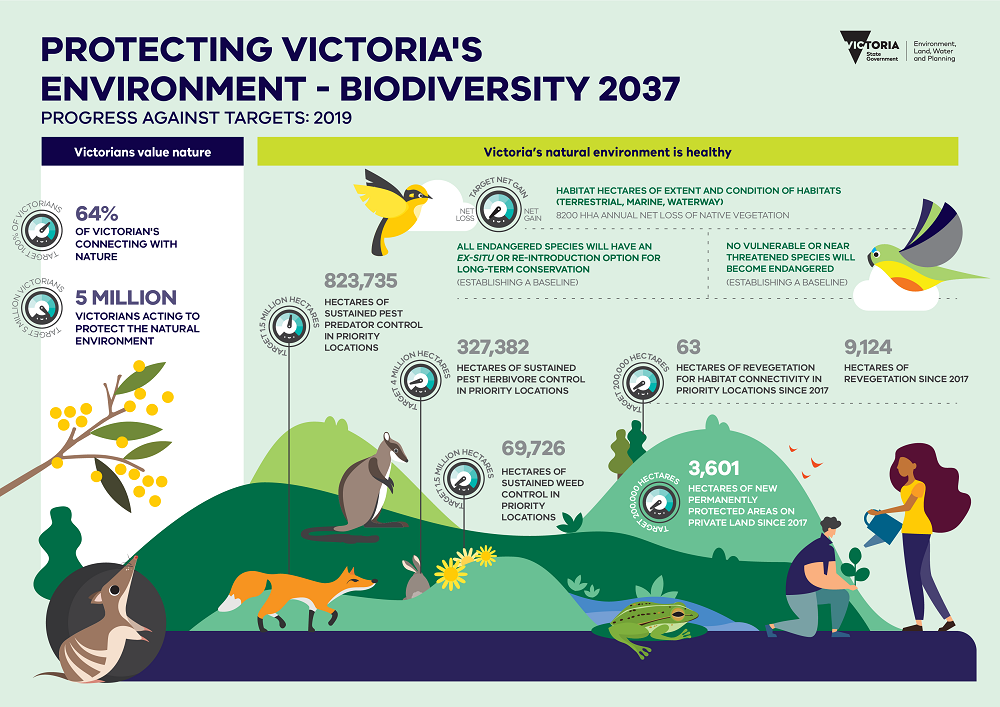
See the accessible version here for this infographic (DOCX, 37.9 KB)
2019 Case Studies
Progress Highlights 2019
See what key initiatives were underway by DEECA and other agencies as at the end of 2019 to progress the various components of Biodiversity 2037.
Biodiversity Response Planning projects 2019
See what Biodiversity Response Planning projects were undertaken in 2019 by the community, non-government organisations and government agencies. See here for further information about Biodiversity Response Planning projects.
The 2018 progress report details the achievements of government environmental agencies and partners over the 2017-18 period against the priorities and themes of Biodiversity 2037.
It includes progress towards the Biodiversity 2037 targets. This analysis against targets utilised partial threat management data as the best data available at that time.
Page last updated: 30/10/24

